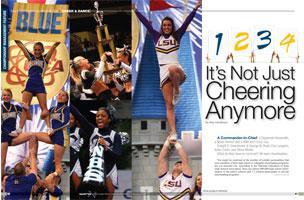
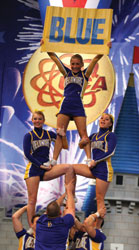 |
| Photo courtesy of UCA/Varsity |
A Commander-in-Chief, a Desperate Housewife, a News Anchor and a Wild and Crazy Guy. Dwight D. Eisenhower & George W. Bush; Eva Longoria; Katie Couric and Steve Martin. What do they have in common? All were cheerleaders.
You might be surprised at the number of notable personalities that were members of their high school or collegiate cheerleading programs, but you shouldn't be. According to the National Federation of State High School Association, there are almost 400,000 high school cheerleaders in the public schools and 1.5 million participants in all-star cheerleading programs.
Rah Rah Rah – It Really Started Like That
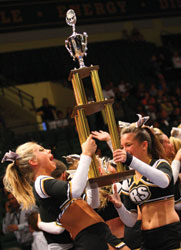 |
| Photo courtesy of UCA/Varsity |
In 1898 Johnny Campbell introduced the University of Minnesota and the world to cheerleading as the first male cheerleader with the following rally call, "Rah, Rah, Rah! Sku-u-mar, Hoo-Rah! Hoo-Rah! Varsity! Varsity! Varsity, Minn-e-So-Tah!"
Like most sports origins, cheerleading began as a male dominant sport; however it's estimated that 97 percent of cheerleading participants are female today. The sport didn't enter the professional ranks until the 1960's and it wasn't until the 1972-1973season that the infamous Dallas Cowboy Cheerleaders made their debut. Although, gymnastics had been the staple of routines, the Dallas Cowboy Cheerleaders incorporated more dance moves and brought a whole new awareness with revealing costumes and choreography during the 1976 Super Bowl. It was 80 years after its debut that cheerleading would be broadcast on national television with the Collegiate Cheerleading Championships on CBS in 1978. Today competitions are broadcast on ESPN.
The levels of competition alone is mind boggling; ages of competitors range from 4 to 18 years and can be broken down into Tiny, Mini, Youth, Junior, Junior International, Junior Coed, Senior, Senior Coed and Open International divisions.
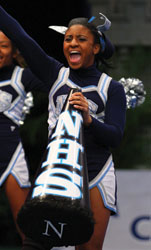 |
| Photo courtesy of UCA/Varsity |
Unlike most sports where there is one governing body,cheerleading is broken down into six major categories-recreational, special needs, high school, all star, collegiate and professional-with each administering its own rules and regulations, safety requirements, tournaments and judging. National Cheerleaders Association, United States All Star Federation, Universal Cheerleaders Association, World Cheerleading Association and American Association of College Cheerleading Coaches and Advisors are just a sampling of the groups that hold regional and national competitions.
So what exactly does this mean when hosting a Cheer and Dance competition? Simply put, revenue-not only for the clubs and event organizers, but also for the destination with hotels, restaurants, entertainment and more.
Heads in Beds
Cheerleading Worlds is held at Walt Disney World in Orlando, Florida and marketed as the World Championship of all star cheerleading by Varsity Brands, Inc. Over the course of four events spanning between January and March on an annual basis, Varsity books more than 40,000 hotel rooms at Disney. Over the course of a year, they host 475,000 competitors and train 350,000 athletes at camps.
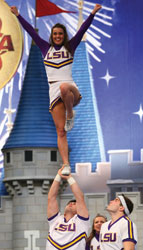 |
| Photo courtesy of UCA/Varsity |
Likewise, Cheersport has been hosting one of the largest national Cheerleading & Dance Championships in Atlanta since 1997. In 2009, 840 teams were represented totaling over 18,000 competitors in the Georgia World Congress Center over 3 days. The competition encompasses a total of 1 million square feet of space, 17,000 room nights and has a direct economic impact of $34,870,000 for the Atlanta area.
"This event is so near and dear to our hearts," said Bob Schuler, vice president of Sales and Convention Services for the Atlanta Convention & Visitors Bureau. "Because it started so small and we've seen it grow. We coddle this event and we like to use it as a showcase to show how easy and family friendly we are."
A large part of its growth can be attributed not only to the sport itself but convenience of the destination. "Getting to Atlanta has made that easy," explains Schuler. "So many folks drive here and the venue and our hotel packages are both downtown. There are five 1,000 room hotels within 5 blocks. The infrastructure has allowed this event to grow. They can walk very easily downtown from hotel to hotel and there is so much to do downtown."
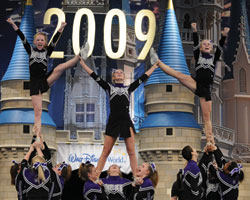 The Delta Plex in Grand Rapids, Michigan has hosted several Cheer & Dance competitions. "Overwhelmingly, with girl's sports we see a larger travel party. With 200-800 competitors, you get three to four people in each travel party," said Mike Guswiler, executive director of the West Michigan Sports Commission. "We see more room usage, larger restaurant checks and when they aren't competing, they are looking for things to do. We've seen such growth in the spectators coming with these groups, and the capacity of seating at the event is increasing, which we love."
The Delta Plex in Grand Rapids, Michigan has hosted several Cheer & Dance competitions. "Overwhelmingly, with girl's sports we see a larger travel party. With 200-800 competitors, you get three to four people in each travel party," said Mike Guswiler, executive director of the West Michigan Sports Commission. "We see more room usage, larger restaurant checks and when they aren't competing, they are looking for things to do. We've seen such growth in the spectators coming with these groups, and the capacity of seating at the event is increasing, which we love."
Tom Lorenz with the Pershing Center in Lincoln, Nebraska couldn't agree more. "It's an all day event with multiple teams and parents and we see great building usage," said Lorenz. "We see revenue streams from food and beverage and families coming in for long period of times. "It's a very family friendly sport," Lorenz continued. "They have kids anywhere from 3-5 year olds to high school (competitors) so it's exciting to see an event that brings the whole family in."
Some of the deciding factors when choosing a destination are venue and hotel availability, but also equipment, amenities and rental fees."We are able to get equipment from the University of Nebraska and put the components together for what the event planner needs," said Lorenz. "We also have an in-house sound system which can save the event planner money because they don't have to travel with that type of equipment."
For the event planner, while all of those details are relevant, so is the community.
"We have to know that there are enough teams in the immediate area to support an event," explains Emmitt Tyler, co-owner and vice president of Jam Brands. "We then discuss potential dates with potential customers to see if there is an ideal day that works for the majority of teams in the area."
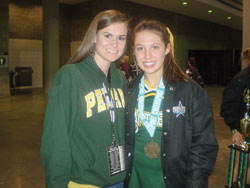 Jam Brands is one of the leading companies within the spirit industry that provides competitions, camps, uniforms and apparel, conference and choreography services.
Jam Brands is one of the leading companies within the spirit industry that provides competitions, camps, uniforms and apparel, conference and choreography services.
It's More Than Just Poms Poms
From humble beginnings, cheer and dance has evolved into a sport that requires extensive athleticism, strength and coordination.
The way we viewed cheerleading changed forever when the Dallas Cowboy Cheerleaders catapulted cheering to a national audience. Dance has become an emphasis for professional ranks but gymnastics is still the core of the sport at the high school and all star levels. Routines and performances require more athleticism and the physical abilities to perform at higher levels which translate to extensive training.
Greta Sherwood has been judging competitions for the past 13 years and has traveled extensively averaging 15 competitions annually.
"Cheerleading, like all sports, is constantly evolving," said Sherwood. "From the style of dance moves performed to the difficulty of skills executed." As a former cheerleader for the University of North Carolina at Charlotte, Sherwood began cheering at the age of 6. "Not only does it come down to whether you can perform a particular jump and motion sequence, now you are required to have the strength and physicality for tumbling," she explained. "Gymnastics has so much to do with it. It's really hard to teach someone how to be a fluent gymnast without years of training."
Physical requirements are not the only things that have changed within the sport, "The biggest change in my opinion would be the explosion of participation in All-Star Cheerleading," said Tyler.
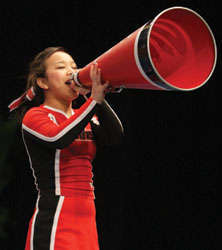 Sherwood couldn't agree more. "The most obvious change I see is within the sport itself with the creation of all star cheer gyms," said Sherwood. "No longer do girls and guys necessarily support a designated team but rather compete all over the country against athletes equally matched to their level of athleticism."
Sherwood couldn't agree more. "The most obvious change I see is within the sport itself with the creation of all star cheer gyms," said Sherwood. "No longer do girls and guys necessarily support a designated team but rather compete all over the country against athletes equally matched to their level of athleticism."
From Tube Socks to Tube Tops
Spirit apparel and merchandising has exploded over the past several years. Apparel runs the gamut from skirts and shorts to tops and sweatshirts to socks and shoes and that's just part of it.
But just how big is the spirit industry? In 2006 Varsity Brands exceeded sales of $156 million and controlled more than 60 percent of the industry. Varsity estimates that it outfits approximately one million athletes each year and the industry exceeds over $200 million in the United States alone.
Uniforms continue to be the bread and butter of the apparel side of the business. "It seems that the trends are constantly changing but for now it appears that active, performance wear is what's in," said Tyler.
"Some teams buy two uniforms," explains Sheila Noone, vice president of Public Relations for Varsity Brands, Inc. "Other teams buy one uniform and an additional shell or a variation on the skirt. They choose pieces that can mix and match."
Retail space is a key ingredient when choosing a venue. Varsity Brands utilizes 70,000 to 100,000 square feet of space for competitions that includes space designated solely for retail usage. "Teams want to commemorate the event," explains Noone. "We sell a lot of programs, t-shirts and sweatshirts. We have merchandise at several locations. There is a spirit shop at check-in and throughout the venue."
"Merchandising plays a big role in our overall event revenue," said Tyler. "Whether it is our own event-specific merchandise or vendor booths, retail merchandise income helps pay the bills in a big way and space availability and location are key to that goal."
But the cheer and dance industry isn't stopping at clothing. Nintendo Wii and Nintendo DS have gotten into the game as well with the launch of All Star Cheer Squad and Wii Play Poms; in 2008, Hasbro also released a limited edition cheer version of one of the most popular board games of all time – Monopoly Cheer.
With Change Comes Risk – Moving Forward
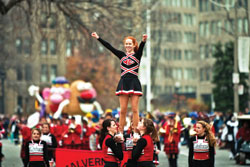 |
| © Daedal - Dreamstime.com |
According to the National Center for Catastrophic Sports Injury Research at the University of North Carolina at Chapel Hill, cheerleading leads all other female sports in injuries for high school and college. The study covers data over 26 years and does not include the all star category. The American Association of Cheerleading Coaches and Administrators was established to help streamline training and safety measures among high school and collegiate level cheerleaders. According to reports from AACCA, emergency room visits decreased by 3 percent from 2001-2006 for the high school and college age group due in large part to safety certified coaches and adequate training.
Technology is beginning to play a key role in competitions. Computerized judging is being introduced as a form of score keeping. "The obvious benefit is the lack of room for human error is considerably less," said Sherwood. "The second is that it allows judges to offer more effective constructive criticism."
The internet also allows teams to view competitions online. Varsity Brands averages 1.5 million video streams per month.
That's not the only change on the horizon; its rapid growth is not only in the United States but going global. "I would like to think that we have not seen the best yet," said Tyler. "I foresee the growth of our sport internationally to be the next big thing."
That big thing is beginning its ascension according to Noone. "It's really growing internationally," she explains. "Globally there are 80 countries competing in cheer and dance that we know of. There are more than 65 countries represented at our event in April in Disney. It's exciting to see what other countries do (with their routines)."
In any language, cheer and dance competitions are great for any destination.

